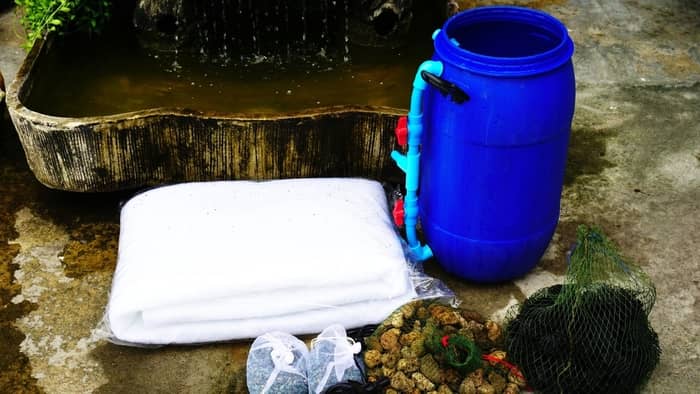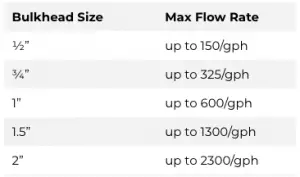Last Updated on October 21, 2022 by Griselda M.
Have you worked with a Fish Tank Sump Pump Size Calculator before? If you have worked with aquaponics before, you know the important role sump tanks play in your system. Every sump tank requires a pump to return water to your tank. This article will overview important information on how to calculate your fish tank sump pump size.
First off, the size of your sump tank depends on your tank volume. Once you know the details of your system, you will easily be able to calculate your fish tank sump pump size. Before we get started, let’s overview the role Sump tanks play in your aquaponics system.
Sump Tanks Explained
Very simply put, a sump tank is an exterior container that sits at a lower gravity point than your main tank. This can be in the form of a plastic tub or as an additional glass tank. Don’t be afraid to be creative and use any other container that can hold water.

Why do you need it? A sump tank is a convenient and clean way to process your tank water without needing to do it inside the main area. It allows you to clean out all the excess buildup in your water without needing to remove the tank contents.
This is because it can process all parts of the water in your system rather than only a portion of the tank water. In a system without a sump tank, the pump location will be at the bottom of your tank. This affects which parts of the water get pumped and filtered.
The water from your main tank drains out into the sump where it can be processed and then re-pumped back into your system. Since the water is separate, you have a lot of freedom with how you process it. Some people add a Protein Skimmer, a PH balancer, Refugiums, and more.
Of course, there are some considerations for the pump needed to operate your sump effectively. The main thing is that you want the water to flow seamlessly from the main tank to the sump and back. The water leaves the first tank and enters the sump via gravity through a drain hole in the bottom.
The goal is to choose a pump that does not overflow the Sump tank or the Main tank!
Fish Tank Sump Pump Size Calculator
How Much Water Flows Through Sump?
To calculate the pump needed, start with your main tank volume. For this article, we will say our tank is a typical 250-gallon tank. This will help us determine how much water will be flowing through your sump.
For any tank, the amount of water that will flow through your sump and back is determined by a few key factors:
- The size of your drain space that feeds your sump tank
- The size of your Bulkhead (the hole where the water comes out)
Here is a general chart that shows the size of the bulkhead and how many Gallons Per Hour (GPH) it can handle:

This means that the GPH on your return pump from the sump should not exceed these amounts!
Choosing Your Return Pump For Sump
The type of pump you need is based on your bulkhead size and linear drain (the area where the water flows out of your main tank down into the sump).
Submersible and Inline Return Pump for Fish Tank
Two things to consider when choosing a pump are:
- The GPH (gallons per hour) rate, is the strength of the pump and how many gallons it can move per hour.
- The Pump Head Pressure- This means the height the pump can reach when moving against gravity. The information is usually on the pump- but it can also be calculated by looking at all the components in your system. You need to make sure the pump can reach the top of your main tank!
Here is a general guideline to determine how many feet of pump head pressure you will need based on all your connecting pieces. You can see that an elbow connector is equal to needing 1 extra foot of head pressure. Every 10 feet of sideways pipe requires 1 foot of head pressure.
You must map your piping out before buying a pump!

GPH Calculator – How Much Do I Need?
There is a simple equation you can use to calculate the Gallons Per Hour rate needed. Typically you can use the basic rule of five gallons per hour for every gallon of water in your tank. So, for example, a 250-gallon tank would require a 1250 GPH pump (multiply 250 x 5).
When a pump is labeled a certain GPH it indicates the maximum amount it can flow when not connected to anything. Please note that once your pump is connected to pipes this flow rate will decrease. If you want a pump that provides 200 GPH, make sure you get something that goes higher than 200 to account for this difference.
It is very important to note that this depends on how often you plan to be pumping water in and out of your system. The University of Arizona recommends that you drain and pump tank water for 15 minutes, four times a day (a total of 1 hour per day).
To make your system function seamlessly, you may consider getting timers on your pumps so your water changes are automated. In this case make sure you have all your electronics set up cleanly, ensuring they won’t get wet.
Take It Slow and Do It Right
There are many things to consider when setting up your sump tank. I would say that making sure you have an adequate pump for your needs is one of the top priorities.
This cannot be determined until the whole system is planned out. Make sure you design all other details such as tank size, pipe layout, and type of system before calculating your fish tank sump pump size.
Once you have that ready, you can use this guide to calculate your fish tank pump size! Don’t be intimidated by all the information. Go slow and pay attention to details.
Feel free to comment and ask questions below.
Read more about: Aquaponics Grow Bed Calculator

Candace is an aquaponics expert with over 5 years of experience in the field. She has a degree in environmental science from the University of California, Berkeley and a degree in aquaponics from the University of Florida. She is passionate about sustainable agriculture and has a deep knowledge of aquaculture and hydroponics. She has worked on numerous projects and has been involved in the development of aquaponic systems and fish farms. She also has experience in designing and constructing aquaponic systems. With her expertise, Candace is able to advise clients on the most effective and efficient way to construct and manage their aquaponic system. She is an active member of the aquaponic community, often speaking at conferences and seminars. Candace is dedicated to helping others understand the importance of aquaponics, and she is a strong advocate for sustainable food production.



